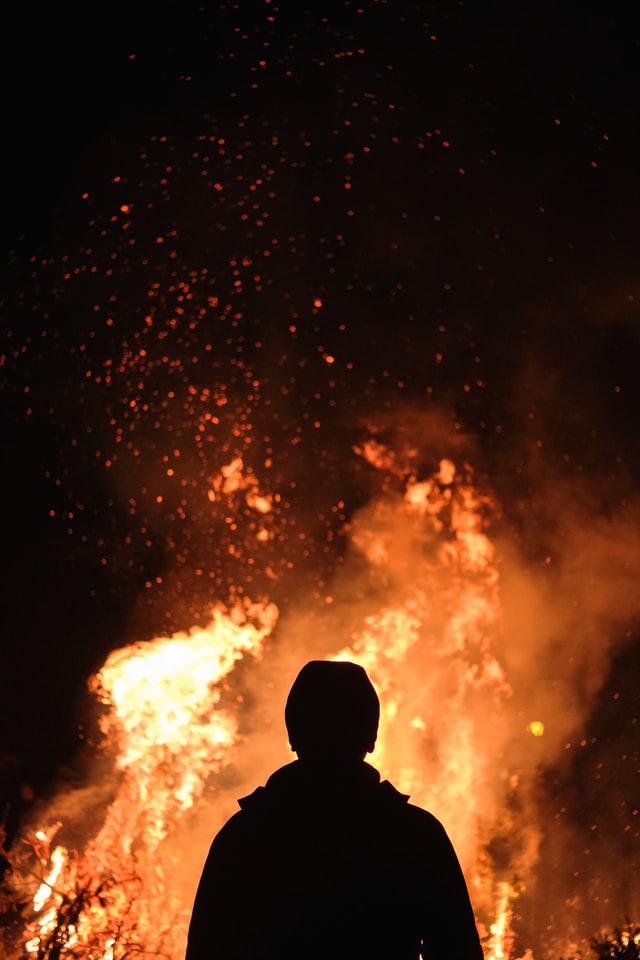
Massive forest fires have been going on for hundreds of years.
Long before man inhabited the regions of the North-Western United States, fires have burned millions of acres annually, and the same is true for many other regions of the world, especially Canada and Australia, which like America, are relatively newly inhabited. Remarkably, and surprisingly underreported, 2021 fires in Russia’s uninhabited Siberian region burned more acres of land than all the fires in the world combined, yet few are aware of these fires.
Obviously, many fires are “natural” fires, igniting from lightening or fire-carrying birds that carry flaming twigs in their beaks or talons from an existing fire, to start a new one—in order to scare snakes, rodents, and insects from their dwellings to feast upon. Other predators also benefit from fires by preying on these fleeing animals. Bears, raccoons, and raptors, for instance, have been seen hunting creatures trying to escape the flames.
Some forest systems need fires to seed future trees and rid the forest of evasive species. The giant Sequoias and Redwoods in the Northwestern United States, for example, seed via pinecones that will not open and burst out their seeds without the heat of fire. That is why brush fires are essential in these regions, for without indigenous saplings, invasive species would take over and eventually smother out the Redwood and Sequia forests. The bark of Giant Redwoods and Sequoias can be as much as two-feet thick and is fire retardant. It can withstand brush fires burning throughout their habitats whether they are the result of nature or induced “backburning.”
Other plants, animals, and birds actually require fire too. Heat from the flames can stimulate some fungi, like morel mushrooms, to release spores. Certain plants will seed only after a blaze, and some animals, such as mule deer and black-backed woodpeckers, require burned areas to both eat and nest. Without fire, those organisms can’t reproduce—and anything that depends on them will be affected.
Controlling fires through backburning was known to Native Americans for many centuries and scoffed at by modern firefighters; but not anymore. They now employ Native Americans to share their knowledge of backburning to keep forests healthy and of manageable size through conscious fire management—to assure the right balance of charred and green areas, and that the necessary heat is generated in major forests to open the cones of mature seeds to assure they grow new saplings.
While fire may benefit some species, overall, it’s a disaster for most forest dwelling animals and even birds.
Whether they run or hide, their choices are not good. Smaller animals often try to climb trees, resulting in burnt paws or being trapped, and rodents will hide under rocks or logs, or burrow into the ground. Temperatures were taken under logs that reached 1,200 degrees Fahrenheit and even two inches below the soil, the temperatures were 200 degrees Fahrenheit. In large fires birds also die in massive numbers, as the smoke deteriorates their lungs when they fly miles to escape.
If there is water around, large and small animals will often find salvation in rivers and lakes. I remember a fire in Los Angele’s Topanga canyon in the 70s when a surfer friend of mine was living there. He left his home and jumped into the ocean to escape the flames. He said a large number of deer were doing the same thing. In Lake Tahoe’s recent fire, bear, elk, and deer jumped in the lake.
In addition to fires disrupting the habitat of wildlife, there is the heavy equipment digging fire lines, bright lights, thousands of firefighters, and helicopters bombing areas with flame retardant, disrupting animal habitat, and causing disorientation to the wildlife. Firefighters prioritize properties and protecting people’s lives—they do not look after the wildlife. There are wildlife rescues that the fire department recommends calling for animals or pets.
Fires in California, Washington, and Oregon have burned approximately six million acres in 2021. Some of these fires were large, ranging from 200,000 to almost one million acres. At least 35 human lives have been lost and hundreds of structures destroyed. The cost on wildlife is not yet clear but it is feared it will be substantial, inflicting lasting damage on species and ecosystems. In particular, ecologists worry the loss of habitat could imperil species with small populations or restricted ranges, and that incinerated ecosystems will fail to rebound in a warming climate, leading to permanent landscape changes.
Exactly what happens after a fire occurs depends on the landscape, the severity of the fire, and the species involved. But the event always sparks a succession of changes as plants, microbes, fungi, and other organisms recolonize the burned land. As trees and plants age, light and other features change—and the composition of creatures in the area changes in response. Streams and other water bodies that flow through a burned area can also change. Water flow, turbidity, chemistry, and structure can be altered. Fish may temporarily move away. And there can be short-term die-offs among aquatic invertebrates, which can affect animals on land. It is also known that many birds will not re-inhabit a region that is large after a fire, because of the nearby absence of adjacent trees. Even years after the 2015 fires in the Northwestern United States, migratory and other birds have yet to return to their former homes and nesting regions.
“We are in unchartered territory here, and we just don’t know how resilient species and ecosystems will be to wildfires of the magnitude, frequency, and intensity that we are currently experiencing in the U.S. West,” says S. Mažeika Patricio Sullivan, an ecologist at the Ohio State University, Columbus.
We are custodians of our environment.
Many of us are being responsible citizens by playing our part and respecting everyone else. Some are changing their diet to consume less animal products and use less leather in their cars and clothing. Since raising animals requires clearing large amounts of land for them to graze and scant water resources for their consumption, our choices can play a vital role in protecting the planet. Consuming less meat is better for our health too.
We can be active in reforestation and use less wood. Our dependence on fossil fuels can be lessened by the use of fuel efficient vehicles or electric or hybrid cars. Of course, industry needs to play their part. Without industry becoming more conscious, they will continue to be a major contributor to global warming.
Many concerns have been raised regarding how food and goods are delivered to the consumer. Packaging requires raw materials and energy to produce and destroy. We must turn to reusable packaging. During a two year stint in India and Nepal, I diligently washed the inside and dried my plastic bags and reused a handful of bags for two years. We can do this throughout the world and it’s far more ecologically sound than the use of paper bags which are made from trees. Plastic can be reused endlessly.
If consumers played their part by demanding it, many products now in plastic or glass, like milk and yogurt, could be made available for consumers who bring their own containers to refill. In India and Nepal both are available this way and the region is more populated than the United States. If a poor country can do this, why can’t we?
It is a challenge to be conscious of how we use the environment when almost everything that is available is available for the “sake of convenience.” It is awkward to go against the flow and try to use less containers and avoid unnecessary foods and convenience items altogether. But, by challenging ourselves to do so, we are making ourselves more sensitive to our own needs in the process and discovering how to appreciate our foods more, and how making better use of the items we have can be more rewarding than replacing them on a whim.
Living like the poor is not only for the poor; but the rich as well. We are a “consumer society” and our proclivity to consume eats away at our well-being and distracts from who we are. This author has found more joy in poor communities during two decades in Nepal and India than in the West by far. The people in these poor communities value what little they have as we do our abundance, and are more connected with each other and nature.
The Himalayan regions of Nepal and North India are heavily forested up to about 12,000 feet, yet I never heard of a forest fire in Nepal or India during my entire stay in these countries. Perhaps it is because these areas are populated that when fires do start, they are more likely to be put out quickly. If so, this could be a cue for us to have monitoring systems like we do for earthquakes, to alert us to fires while they are small and containable. Such a system might mimic the effect of having people spread throughout a region and provide early warning.
If we wish to be happier people, we can have what we need but we don’t have to have everything we want. A well-to-do person who lives as if of little means will know happiness inside, where it counts, and know a happiness that does not have to be replenished.
If we cannot find it within ourselves to protect the planet for the planet’s sake, how can we find it for our own?











Read 0 comments and reply